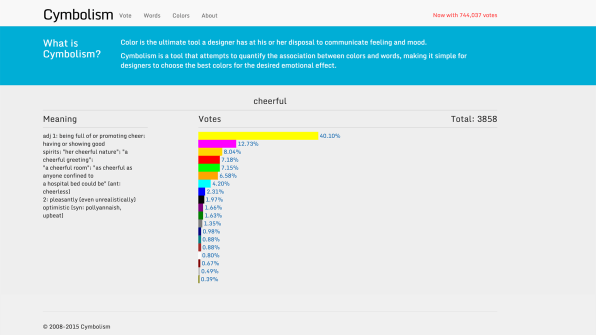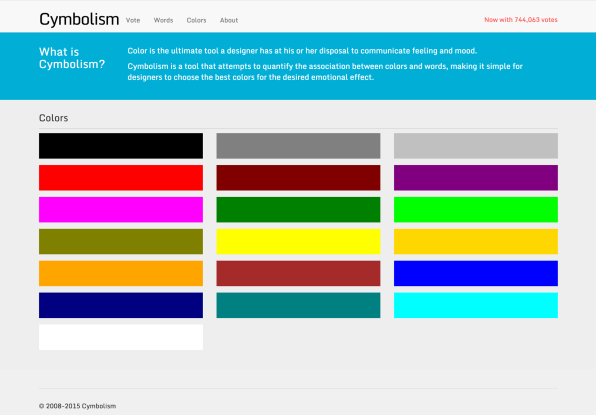Change Background Color of Every Site Visited
What color is the word "music?" How about the colors of words like "spiffy," "cookie," "devil," and "cottage?" Making associations between words, colors, and feelings isn't just reserved for those with synesthesia–we all do it. Designers know this, and use color as a primary tool for conveying mood.
"Cymbolism," a new project by designer Mubashar Iqbal, attempts to quantify the associations between colors and words through crowdsourcing. It presents a random word and its definition next to a palette of colors, and lets you vote on which of those colors you most strongly associate with that word. You can then see how your responses compare to others'.

The site also serves as a color-coded dictionary of sorts, with an alphabetized list of all words and a breakdown of how many votes per color each has received. You can also see the top words associated with each color. This offers designers a way to better know which colors convey which moods and concepts–are the colors they choose likely to invoke the desired emotional reaction?
"Typically, you'd have to wait until after the design was done and put it in front of people too see their reaction," Iqbal tells Co.Design. "With Cymbolism, you can do this at the beginning of the design process."
But there are some anomalies. A few colors are strongly associated with pairs of words that convey opposite feelings: maroon, for example, is paired with both love and war. Most colors' word families, however, strongly represent one emotional tone, and confirm associations that have prevailed throughout time and across cultures. For example, aqua is the color of calm words like paradise, peaceful, and blissful; yellow is the color of happy words like sun, summer, joy, fun, and jubilant; red is the color of love, sex, passion, and the devil.

But not everyone agrees with these predominant associations: "For me, the biggest finding has been that as an individual, I may have a clear association between a word and color, but that may not be the generally accepted association," Iqbal says. "For example, when I think of the word 'cold,' I think of the color blue, yet this only accounts for 13% of the associations." The color cyan garnered many more votes, nearly 30%.
Aside from comparing how your own associations compare to others', what's most interesting is seeing the words without immediately obvious associations. We all know "goth" is black, but what is "drunk?" A pukey green, according to 16% of voters. "Cottage" is a mossy olive. Concrete-filled cities and boroughs, like Chicago and Brooklyn, are gray. And voters overwhelmingly associated "god" with white.
Iqbal originally drew inspiration for the project from books he'd read on color psychology and the links between emotion and color. He found this was often presented more as an art than a science. "Cymbolism attempts to make this a little more scientific," he says, by crowdsourcing data. Still, while the data gathered is a start, it's not a rigorous scientific analysis. What the site doesn't address is why we associate colors with particular words, something color psychologists have been contemplating for centuries. Maybe with enough data, this site can yield some new insights.
Change Background Color of Every Site Visited
Source: https://www.fastcompany.com/3042581/this-site-quantifies-associations-between-words-and-colors
0 Response to "Change Background Color of Every Site Visited"
Post a Comment